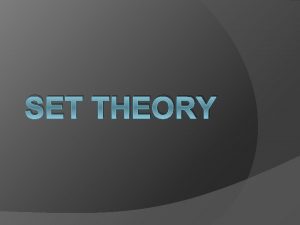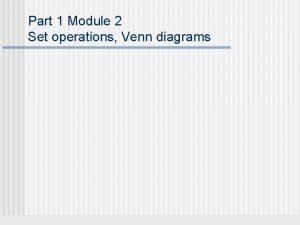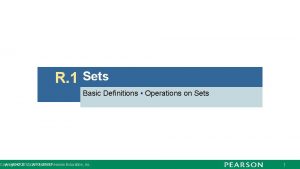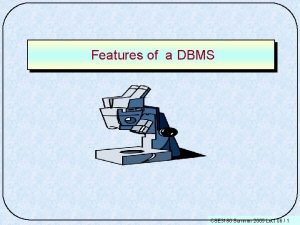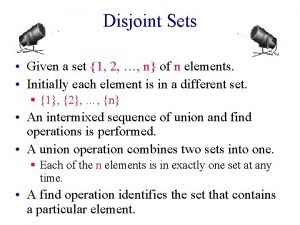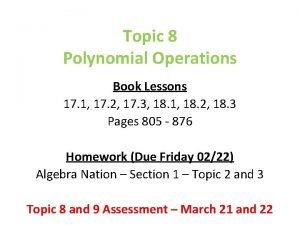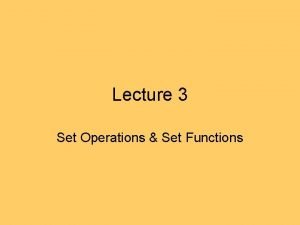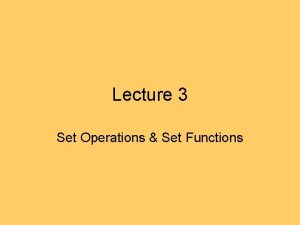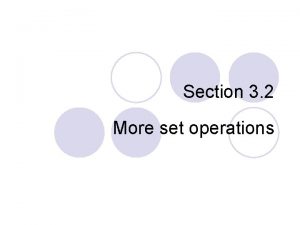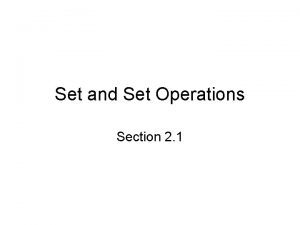Set Operations Section 2 2 Section Summary Set











- Slides: 11

Set Operations Section 2. 2

Section Summary Set Operations Union Intersection Complementation Difference Cartesian Product Set Identities Proving Identities

Union Definition: Let A and B be sets. The union of the sets A and B, denoted by A ∪ B, is the set: Example: What is {1, 2, 3} ∪ {3, 4, 5}? Venn Diagram for A ∪ B Solution: {1, 2, 3, 4, 5} U A B

Intersection Definition: The intersection of sets A and B, denoted by A ∩ B, is Note if the intersection is empty, then A and B are said to be disjoint. Example: What is? {1, 2, 3} ∩ {3, 4, 5} ? Venn Diagram for A ∩B Solution: {3} U Example: What is? A B {1, 2, 3} ∩ {4, 5, 6} ? Solution: ∅

Complement Definition: If A is a set, then the complement of the A (with respect to U), denoted by Ā is the set U - A Ā = {x ∈ U | x ∉ A} (The complement of A is sometimes denoted by Ac. ) Example: If U is the positive integers less than 100, what is the complement of {x | x > 70} Solution: {x | x ≤ 70} Venn Diagram for Complement Ā A U

Difference Definition: Let A and B be sets. The difference of A and B, denoted by A – B, is the set containing the elements of A that are not in B. The difference of A and B is also called the complement of B with respect to A. A – B = {x | x ∈ A x ∉ B} = A ∩ B A U B Venn Diagram for A − B

Review Questions Example: U = {0, 1, 2, 3, 4, 5, 6, 7, 8, 9, 10} A = {1, 2, 3, 4, 5}, A∪B Solution: {1, 2, 3, 4, 5, 6, 7, 8} 2. A ∩ B Solution: {4, 5} 3. Ā Solution: {0, 6, 7, 8, 9, 10} 1. 4. Solution: {0, 1, 2, 3, 9, 10} 5. A – B Solution: {1, 2, 3} 6. B – A Solution: {6, 7, 8} B ={4, 5, 6, 7, 8}

Symmetric Difference Definition: The symmetric difference of A and B, denoted by is the set Example: U = {0, 1, 2, 3, 4, 5, 6, 7, 8, 9, 10} A = {1, 2, 3, 4, 5} B ={4, 5, 6, 7, 8} What is: Solution: {1, 2, 3, 6, 7, 8} U A B Venn Diagram

Tuples The ordered n-tuple (a 1, a 2, …. . , an) is the ordered collection that has a 1 as its first element and a 2 as its second element and so on until an as its last element. Two n-tuples are equal if and only if their corresponding elements are equal. 2 -tuples are called ordered pairs. The ordered pairs (a, b) and (c, d) are equal if and only if a = c and b = d.

Cartesian Product René Descartes (1596 -1650) Definition: The Cartesian Product of two sets A and B, denoted by A × B is the set of ordered pairs (a, b) where a ∈ A and b ∈ B. Example: A = {a, b} B = {1, 2, 3} A × B = {(a, 1), (a, 2), (a, 3), (b, 1), (b, 2), (b, 3)} Definition: A subset R of the Cartesian product A × B is called a relation from the set A to the set B. (Relations will be covered in depth in Chapter 9. )

Cartesian Product Definition: The cartesian products of the sets A 1, A 2, ……, An, denoted by A 1 × A 2 × …… × An , is the set of ordered n -tuples (a 1, a 2, ……, an) where ai belongs to Ai for i = 1, … n. Example: What is A × B × C where A = {0, 1}, B = {1, 2} and C = {0, 1, 2} Solution: A × B × C = {(0, 1, 0), (0, 1, 1), (0, 1, 2), (0, 2, 0), (0, 2, 1), (0, 2, 2), (1, 1, 0), (1, 1, 1), (1, 1, 2), (1, 2, 0), (1, 2, 1), (1, 1, 2)}
 Total set awareness set consideration set
Total set awareness set consideration set Training set validation set test set
Training set validation set test set Set notation symbol meanings
Set notation symbol meanings A-b shaded venn diagram
A-b shaded venn diagram R set operations
R set operations Traditional set operations in dbms
Traditional set operations in dbms Disjoint set operations in daa
Disjoint set operations in daa Polynomial closure property
Polynomial closure property Bounded set vs centered set
Bounded set vs centered set Fuzzy logic
Fuzzy logic Crisp set vs fuzzy set
Crisp set vs fuzzy set Crisp set vs fuzzy set
Crisp set vs fuzzy set


